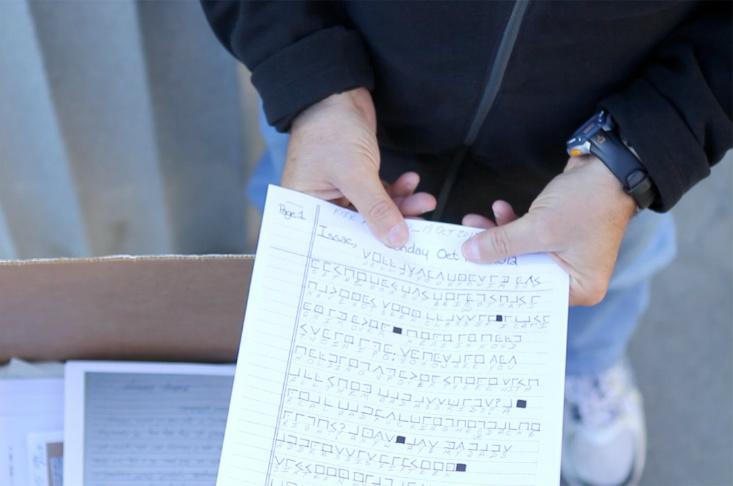
As a corrections officer at a Westchester County, N.Y., prison in the 1990s, Gary Klivans was a one-man gang unit. Members of The Latin Kings and the Bloods made up a sizable part of the prison population. Klivans learned quickly that to handle them, he needed to understand them, and that meant understanding the code they used to communicate. Klivans taught himself to decipher their messages. He became one of the most sought-after code-breakers in the country. (Also see the related Facts So Romantic post, “View From the Inside: How Gang Members Use Secret Codes.”)
Even in retirement, his skills are in demand: Klivans sifts through encoded messages sent to him by law enforcement offers from around the country. “I have a knack for this. I see the patterns,” he told me. “Even as I’m printing the paper out, the words are jumping off the page at me.…A lot of people can’t see what I see.”
Here is the transcript of my interview with Klivans, edited for length and clarity.
What is a gang code?
Codes are substitutes for the letters in our English alphabet. They could be anything—in addition to numbers, they use ornate symbols, a Chinese pictogram, or Mayan or Aztec symbols. Or they create their own symbols. And the languages vary widely. There is no one Blood or Crip gang code or Black Gangster Disciples code that all the members use. The codes are all local. So if you’re a law enforcement officer in Los Angeles or Chicago, you can travel 10 miles away and you’ll find a different code.

How did you learn gang language?
I had a law enforcement background even before I got involved with gang. I did 30 years in the army reserve and I did 18 with the army CID [Criminal Investigation Command]. Now, the army CID is the army’s FBI; they’re the federal agents. So because of all of this, the department of corrections in Westchester wanted me to become involved with gangs.
The fourth day I was doing gangs, another officer brought me a document that was in code. At first I didn’t think it was important to read, but then I thought, “What if it says, ‘I’m going to kill the cop that arrested me and I know where his family lives.’” I realized we had to decode it.
I sat down with it and tried to get into the writer’s mind. The letter started off in English, which helped. Each gang has its own hierarchy and terms of address. The author referred to a “third crown” and then turned to a mix of Spanish and code. I could tell he was from the Latin Kings since the leader there is called a “king.” I looked for references that would be important to them. I started to notice that the number “3” was followed by five symbols. Since “the third crown” was important to the author, I took a guess and associated the five different symbols to the five letters in the English language that make up the word “crown.”
Then I had another breakthrough. The letters “ADR” kept coming up. The phrase “Amor De Ray” is common in the Kings’ jargon because it means “love the crown.” So now I had seven letters of the alphabet, the five symbols that corresponded to C R O W N and then A D. And once I had seven letters I could figure out the rest. And that was the first code I ever deciphered. With every code, you have to first understand what’s important to the writer.
What did that first code say?
It was a letter from the leader delegating a second crown to take charge while he’s serving his prison term. He also gave them instructions in how to write in code: He said, don’t put “first” on the letter because you’re telling “5-O”—meaning law enforcement—that I’m the leader. He wanted to make sure the police didn’t know who he was.
How do the gang members learn the language?
From each other. Usually someone senior will come up with new codes after the old one was decoded. Then, by word of mouth, the leaders will tell the other gang members, “here’s our new code.” Until the police crack it, and they have to create a new one. It’s a cat and mouse game.
What are some common themes within a gang code that allow you to begin the decoding process?
Gangs have rivalries with other gangs. This animosity plays out in the streets and on paper. Crips gang members scratch out the letter B as a sign of disrespect for Bloods, who are their rivals.
The messages will disparage other gangs in a backhanded way. In a Blood letter, you’ll see that the letter C is usually crossed out or has a slash through it out of disrespect for the Crips. And to praise themselves, they’ll write a B with an up arrow.
What’s one interesting code you had to deal with?
One of the codes I worked with had multiple symbols for each letter. We have 26 letters in the English alphabet. But this code system had 40 symbols. The letter “E” had three different ones. The letter T had two and so on. That’s a very complex code.
One that I did recently was oral. An officer suspected a drug operation and monitored a gang member’s telephone call. The guy spoke and then there was a burst of numbers. He said, “Everything is fine. Everything is cool here, uh, 15 22 27 31.”
As I worked on it I saw that he reversed the alphabet. So I took a leap of faith and assumed that if he was using a letter for a number then that letter would then refer back to another number so that a “3” would be K.
[Klivans found that the code split the alphabet into two columns of 13 letters. The first column starts backwards, with A being the 13th letter and then, counting backwards, M is the 1st letter. Then it moves to the second half of the alphabet: N is the 26th letter and Z is the 14th.]
So what happened in the end?
I don’t know. The jurisdictions that I work with rarely get back to me. One of the frustrating things is that I help them but I never hear the rest of this story. My little part is to decipher the code so they can continue monitoring communications.
What have you learned about gang culture—their manners, how they treat their own members or other gangs—based on their languages?
Through the years, I have developed an appreciation for the complexity of their communication. Gangs are their own cultures and societies. Some of the larger gangs have their own holidays. And they have their own laws. They have their own way of meting out justice. You’ll get a beating or termination [get killed] depending upon the severity of the violation. I’ve come to appreciate their belief systems and just how complex and intelligent they are.
Eric Jankiewicz is a student of the CUNY Graduate School of Journalism. He often covers the intersection of crime and science.






























